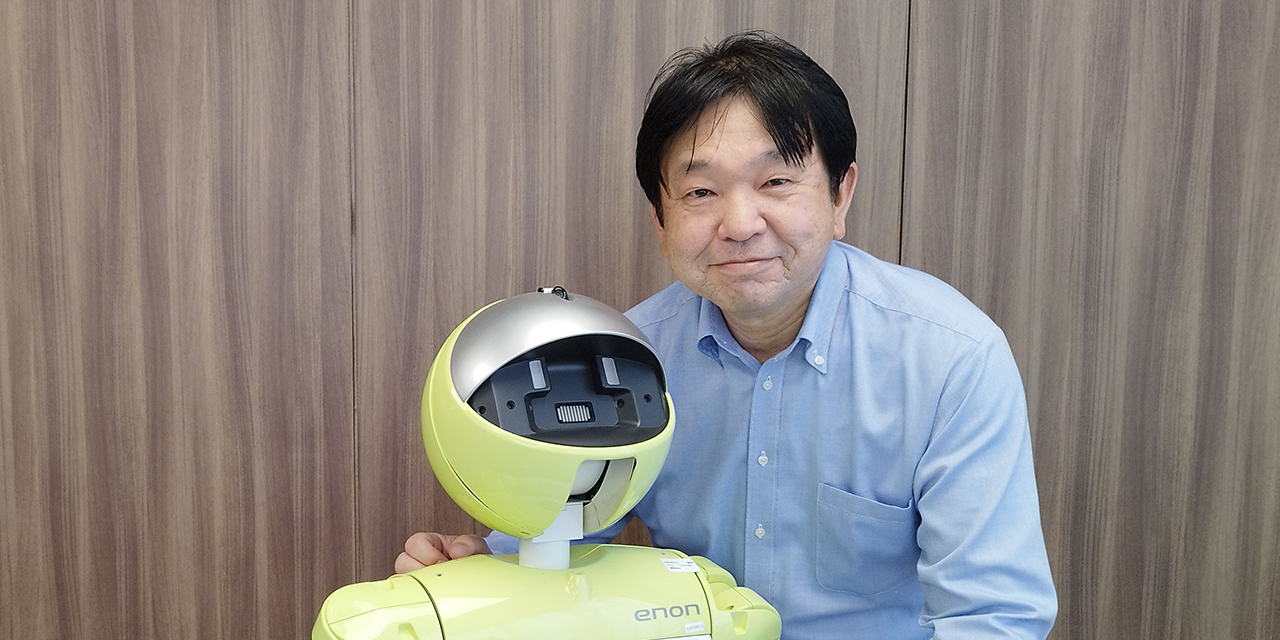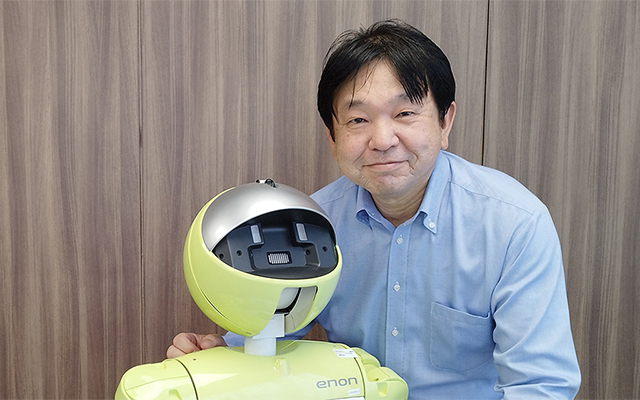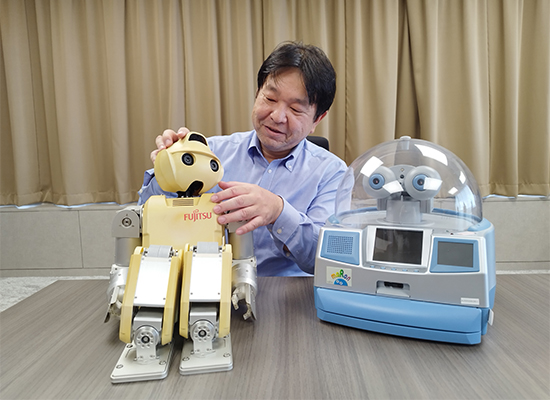"Would you like to travel into space?"
If someone asked you that question, how would you answer? I imagined myself on a space craft, racing through the night sky full of stars and viewing the earth from space. Mysterious planets, the beautiful Milky Way, and me piloting the space robot, touring the universe!
What an exciting dream!
When I was a child, my parents bought me a science encyclopedia. The pages explaining space were falling apart after being thumbed through so much. I was totally captivated by the contents. At the time, NASA's space shuttle was in the planning stages, and there were loads of space-related cartoons on the TV, so my imagination was bursting with space and robots, and I began to dream of a future in space-related work.
As I grew up, my desire to research the unknown about space did not change. As an undergraduate, I studied control theory in the department of electronic engineering, and in graduate school I applied this to space-related research on controlling the deployment of solar panels on satellites. At the time of my graduation, every time I thought about my future career, my childhood memories came back to me. My desire to apply the specialized knowledge I had learned to the space business grew stronger and stronger. At the time, the bubble economy was in full swing, and many of my classmates were working at banks and finance firms, but I decided to enter graduate school to deepen my research. While I was deciding on my future career path, I started to look around at jobs related to the space business, and my future path flowed naturally from this source.
Supercomputers are essential to the development of cutting-edge technology for space. Fujitsu has long history in both Japan and the world for its supercomputer supremacy. The word processor I used in college was Fujitsu's "OASYS," so the company name was familiar to me, as I mastered "thumb shift," which was extremely popular due to its specialization for Japanese text input.
Fujitsu's Toshio Ikeda, who was known as a brilliant engineer, was someone I had admired since I was a student. I was incredibly moved when I heard the famous episode of how he restrained his team of researchers who were about to jump into a fire consuming their factory to retrieve hundreds of irreplaceable handwritten circuit design drawings. He simply told them, "All the drawings are in my head, so don't worry about them.
I decided to join Fujitsu after an invitation from senior student from my university seminar, who was already actively involved with Fujitsu. When he told me that Fujitsu was doing business related to space development, it clinched my decision.
Soon after joining the company, I took on the challenge of researching and developing a robotic arm “ETS-VII advanced robotic hand system” (*1) for use on board satellites. When there is a malfunction in equipment such as satellites, it is dangerous for humans to perform maintenance work in space, so the goal is we to use robots. However, communication between the ground and space also limits the communication time and data volume, and there is a time lag in communication. Therefore, you need to develop a high-precision robot arm that can perform maintenance tasks such as bolt removal and screw tightening autonomously, based on camera and sensor recognition.
At the time, however, space equipment usually used highly reliable but expensive military-grade components. Our mission was to use as many civilian parts as possible to achieve the goal of cost reduction. In order to withstand the strong acceleration of gravity at the time of launch into space, we conducted a tough scrap-and-build development program to determine what parts to use and how to use them, while maintaining high performance.
We conducted repeated experiments throughout the day at various locations, including vacuum tests using a large vacuum testing apparatus at the Fujitsu Nasu Plant that could accommodate several people, as well as shock and vibration tests at the Fujitsu Numazu Plant. All of this hard work paid off, and I will never forget the excitement I felt when I received a picture of the Earth from a camera mounted on a robotic arm that had actually been launched into space.
I have been involved in countless projects since I joined the company. I started with the development of the ETS-VII advanced robotic hand system for space robots. Since then I have been involved in the development of a bipedal humanoid robot capable of dynamic walking “HOAP”(*2), the home robot “Maron”(*3), the “Hello Kitty" PC-connected mascot robot, the "enon" service robot(*4), a ring-type wearable device(*5), and currently I am developing a 3D laser sensor for a gymnastics scoring system(*6).
You may say – not many of these have anything much to do with the space business? It is true that I started out in the space business, but the majority of my career has been spent in robotics development.
Bipedal robot HOAP
The experience in robot arm development led me to the bipedal robot HOAP.
I was determined to finish the project I was assigned, with the belief that I would be able to accomplish and complete the project without giving up. At the time, the automobile manufacturer Honda Motor Company had succeeded in developing a robot that would become the predecessor to ASIMO, and people were talking about the possibility of "dynamic walking" by a bipedal robot, which was assessed as difficult to achieve. Meanwhile, although this was still in the theoretical research stage, we decided that we should build a small bipedal walking robot for research purposes.
Developing something that doesn’t exist anywhere in the world, taking it from the initial idea stage to miniaturization and commercialization, was as difficult as developing a space robot. But the results are amazing - HOAP can write, cook, play tai chi, and even find and kick a ball. It was the most moving experience for me to watch HOAP grow and develop, just like a person. When the project was actually completed, everyone involved toasted and praised each other. It really was a fulfilling experience.
But it wasn’t all plain sailing! One of our challenges was overcoming frequent communication problems with HOAP’s joints. There are 20 different connection points involved in making HOAP’s arm joint move, and if any of these break down, it affects the movement. The most memorable event was when the HOAP stopped working an hour before the press conference announcing it. We dismantled the HOAP on the spot, found the cause of the communication problem, and were able to reassemble it before the press conference. At the time, it was a harrowing experience, but it was an experience that will give me confidence in the future that if I don't give up, I can make it work even at the last minute.
enon service robot
Another of my treasured experiences is developing the enon service robot.
Industrial robots developed during this period mainly operated in factories in complete isolation from people. There were very few service robots designed with the goal of providing services alongside people, cooperating and coexisting with humans.
Our ultimate goal is to create robots that coexist with humans. So for this project we obtain safety engineering certification for our service robot and took great care to conduct a rigorous risk assessment, which was just being introduced at this time. We also conducted a trial-and-error experiment to determine how we could maintain safety, ensuring that the robot could move autonomously without rails while avoiding obstacles, and creating a guidance service that could recognize people and respond to their conversations.
The successful experience of developing enon, which actually interacted with people, motivated me to conduct new research and development. I am also very proud to say that the famous Kyotaro Nishimura liked the system so much that enon has been in operation for nearly 10 years now as a guide service at the Kyotaro Nishimura Museum (*7).
By now, robotics development had not only become a part of my own development, but had also become my life goal, as I had developed a real desire to conduct research and development that would contribute to people's safety in the future. I felt that contributing to society through cutting-edge technology outside of the space field was also a wonderful choice.
My robot development was an important bridge between my original space dream and focusing on people. My next move was to step into the unchallenged field of sports, which is where I am still working today. My development work in hardware technology looked promising for this application, and it proved to be the catalyst that encouraged me to take on new development challenges.
I am currently developing a laser sensor for an automatic gymnastics scoring system. The current project team’s mission is to develop this technology to ensure the accuracy and fairness of judging. I was in charge of developing a 3D laser sensor to measure the movements of athletes accurately at high speed. We can now measure floor events, which are the most difficult we have tackled to date, involving athletes moving around on a flat surface. With this discipline completed, I feel a real sense of accomplishment.
Looking back over every project I have been involved with, I believe that I have always worked as fast as possible to achieve my goals.
I reached an important point where I could tell myself that “I’ve done a great job on research, as well as with raising my children too. It’s time to take a break on my research for now," At that moment, my son's face appeared before me – filled with hope about how his work in the world of shipping would contribute to society. I started to notice news about recent shipping accidents, and began to think a lot about the sea. It came to me in a flash that the oceans and space are equally full of romance and full of things we don't understand.
I feel as if my passion for research has been reawakened. I want to protect the lives of my loved ones. I want young people in future to continue to have bright hopes. I want to continue to conduct research and development that will contribute to the safety of the next generation. People will continue to challenge themselves, because they do not know what will happen tomorrow. I want to keep working on R&D that will help us live past the magic threshold of being 100 years old. Once I had really thought about this and made up my mind to concentrate on this goal, the sky cleared up and the sun came out – on a bright future!






